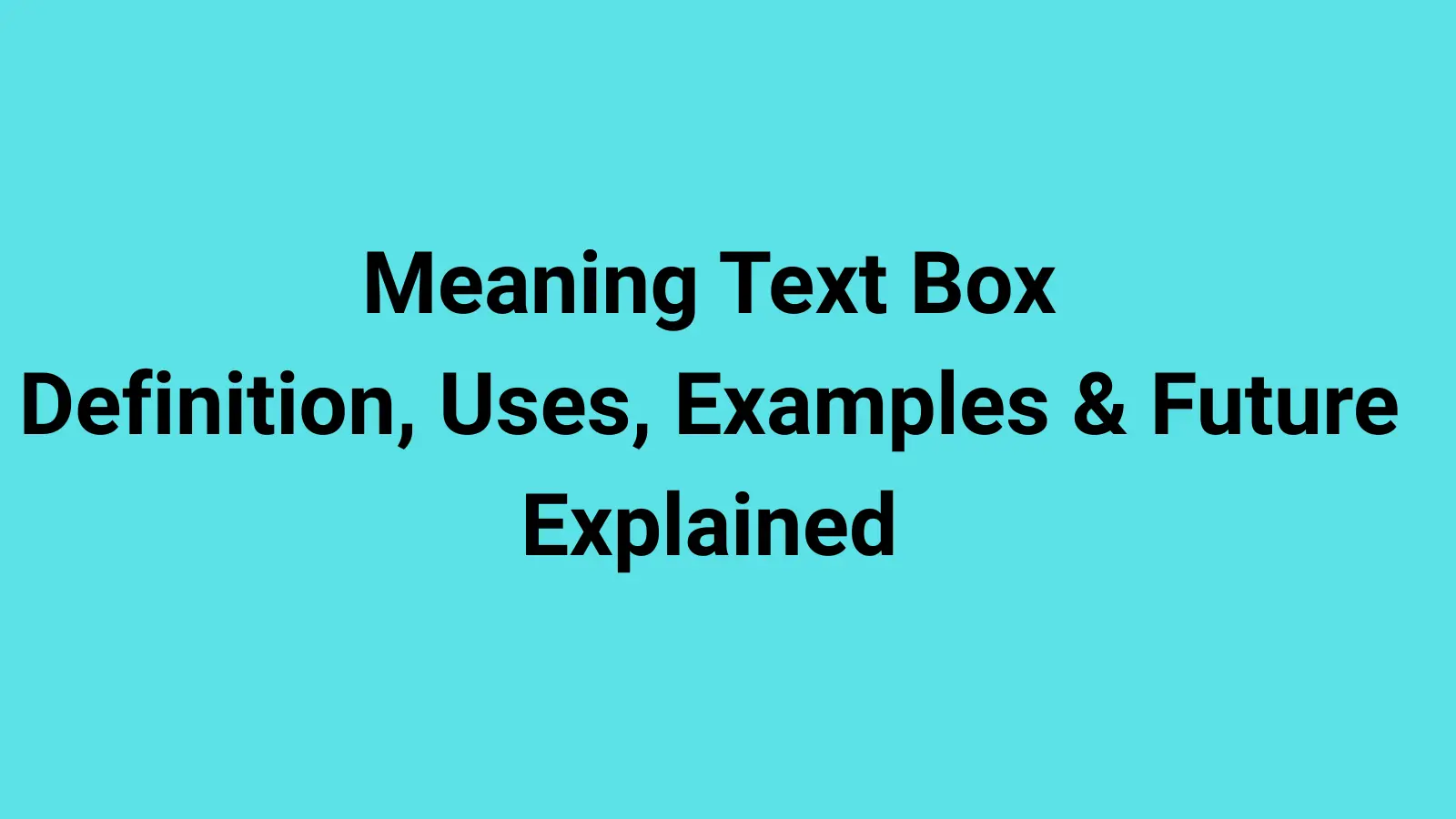If you’ve ever encountered the phrase “meaning text box” while browsing, designing, or using apps, you might have wondered what exactly it refers to.
In simple terms, a text box is a rectangular field or area where users can input, display, or edit text.
When paired with the concept of “meaning,” a meaning text box is usually used to explain, define, or capture the meaning of something — whether in dictionaries, forms, online apps, educational tools, or design interfaces.
From Microsoft Word and Google Docs to website builders and mobile apps, meaning text boxes help users communicate definitions, add annotations, or make content interactive.
This guide breaks down everything about the meaning text box: definitions, real-world uses, examples, design considerations, audience perspectives, history, common mistakes, and future trends.
By the end, you’ll know exactly what a meaning text box is and how it’s used across different platforms.
What Is the Meaning Text Box? 🤔
- A text box is a container that holds text inside a defined space.
- When labeled as a meaning text box, it refers to an area where you input or display meanings, explanations, or notes.
- Common in dictionary apps: a box for the “meaning” of a word.
- Used in academic forms: students type answers/meanings in a text box.
- Found in surveys: “Write the meaning in the text box provided.”
- In Microsoft Word: Insert → Text Box → Add definitions or notes.
- In website design: used to highlight “meanings” or “definitions.”
- Often paired with instructions: “Enter the meaning in the text box.”
- Helps separate main text from explanatory notes.
- Improves readability by visually isolating meanings.
- Editable, moveable, and resizable in digital tools.
- Plays a role in both learning and user interface design.
- Serves as a user-friendly way to structure content.
- Simplifies interaction between user and system.
Meaning Text Box in Education 🎓
- Teachers use text boxes for vocabulary exercises.
- Example: “Write the meaning of this word in the text box.”
- Digital learning platforms (Kahoot, Quizlet) use them.
- Makes it easy for students to practice definitions.
- Encourages active recall in e-learning.
- Exam software often includes meaning text boxes.
- Allows students to type instead of handwriting.
- Interactive worksheets include definition text boxes.
- ESL (English as a Second Language) courses use them heavily.
- Helps learners connect words with meanings quickly.
- Online quizzes depend on them for short answers.
- Gives students freedom to express answers in their words.
- Simplifies grading in automated systems.
- A staple of modern digital classrooms.
Meaning Text Box in Microsoft Word & Docs 📄
- Word has an “Insert Text Box” feature.
- Users often use it for definitions, notes, and side meanings.
- Example: Highlight a difficult word → Add a text box with meaning.
- In Google Docs: Insert → Drawing → Text Box.
- Great for creating study materials.
- Used in reports to define key terms.
- Designers use them to call out glossary sections.
- Can float anywhere on the page for flexibility.
- Improves document design and layout.
- Text box styles (shapes, colors) highlight meanings.
- Supports academic and professional writing.
- Used in infographics for meaning explanations.
- Essential for visual learners.
- Helps keep main body text clean.
Meaning Text Box in Web Design 🌐
- Web developers use meaning text boxes in forms.
- Example: “Enter your meaning/definition in this text box.”
- Useful in Q&A platforms (Quora-style inputs).
- Often coded with <input type=”text”> in HTML.
- CSS styles text boxes for user experience.
- Accessibility features ensure inclusivity.
- Important in e-learning websites.
- Helps users engage with interactive quizzes.
- Design trends: rounded corners, minimal outlines.
- Placeholder text often says “Type meaning here.”
- Security considerations: prevent SQL injection.
- Responsive design ensures usability on phones.
- Can include character limits (e.g., 200 words).
- Makes sites more user-interactive.
Meaning Text Box in Mobile Apps 📱
- Dictionary apps: show meanings inside boxes.
- Note-taking apps: let users insert custom text boxes.
- Education apps (Duolingo, Memrise) use them for answers.
- Social apps: meme creators use text boxes for captions.
- WhatsApp statuses sometimes appear in styled text boxes.
- Keyboard apps (like Gboard) integrate text box fields.
- Survey apps use them for definition-type questions.
- Flashcard apps allow “meaning text box” editing.
- Students love mobile-friendly meaning inputs.
- Quick, intuitive, and touch-optimized.
- Voice-to-text fills text boxes in apps.
- Autocorrect sometimes changes meanings — funny fails happen.
- Emoji integration makes meanings creative.
- Meaning text boxes make apps more interactive.
History of the Text Box Concept 📜
- Early computers (1970s–80s) had command-line text inputs.
- GUI revolution introduced text boxes as clickable fields.
- 1980s: Apple Lisa and early Windows pioneered them.
- 1990s: Text boxes became central to forms and documents.
- WordPerfect and Microsoft Word popularized them.
- 2000s: Web 2.0 forms made them interactive online.
- HTML standard <input> cemented text boxes.
- Mobile era: touch-friendly text boxes emerged.
- Today: AI-powered predictive text enhances them.
- “Meaning text boxes” became common in ed-tech.
- Evolution shows merging of design + communication.
- Always aimed at simplicity in user input.
- Now enhanced by voice and handwriting recognition.
- Future: holographic text boxes?
Examples of Meaning Text Box in Real Life 📲
- Dictionary.com: shows word meanings inside a styled box.
- Quiz apps: “Enter the meaning of resilience in the text box.”
- MS Word: adding notes in a definition callout box.
- Online forms: “State the meaning of this code in the box.”
- Exam portals: digital text boxes for answers.
- Vocabulary games: drag words into meaning boxes.
- Study guides: highlight key terms in boxes.
- Surveys: text box fields for definitions.
- Duolingo: users type translations/meanings in boxes.
- Flashcards: meaning text box vs word text box.
- Caption makers: meme text boxes for funny meanings.
- E-books: pop-up meaning boxes for words.
- WordPress: glossary plugins with definition boxes.
- AI tools: text boxes for meaning suggestions.
Meaning Text Box for Students 📚
- Helps with vocabulary learning.
- Encourages typing over rote memorization.
- Makes revision interactive.
- Students prefer digital meaning entry vs handwriting.
- Helps teachers grade faster in online platforms.
- Improves clarity in e-assignments.
- Allows creativity in definitions.
- Fun when paired with emojis 🌟.
- Builds engagement in virtual classrooms.
- Encourages self-learning (entering own meaning).
- Reduces paper dependency.
- Can be reused across multiple subjects.
- Increases confidence with spelling practice.
- Boosts retention through typing.
Meaning Text Box for Professionals 💼
- Used in corporate training portals.
- Helps employees learn industry jargon.
- Example: “Enter meaning of KPI in the text box.”
- Useful in compliance quizzes.
- Speeds up onboarding in workplaces.
- Professionals use text boxes in reports.
- Glossaries are made interactive via text boxes.
- HR surveys include definition-style boxes.
- Communication tools (Slack, Teams) integrate inputs.
- Software engineers use comment boxes for code meanings.
- Marketing teams annotate campaigns with meaning notes.
- Improves workplace learning culture.
- Reduces knowledge gaps across teams.
- Adds clarity in documentation.
Meaning Text Box in Forms 📝
- Online application forms: text box for explanation fields.
- Example: “State the meaning of your project proposal.”
- Common in visa/immigration forms.
- Academic admission forms include text boxes.
- Feedback forms use them for detailed meanings.
- Complaint forms: “Explain the meaning of issue here.”
- Research surveys depend on them.
- Government portals require input text boxes.
- Banks use meaning text boxes for security Qs.
- Healthcare apps: “Meaning of symptoms” entries.
- Increases personalization in data collection.
- Offers space for open-ended responses.
- Key part of UX design in digital forms.
- Without them, forms would be robotic.
Design Principles for a Meaning Text Box 🎨
- Should be clear and visible.
- Adequate size for comfortable typing.
- Placeholder text for guidance (“Type meaning here…”).
- Good contrast between text and background.
- Responsive: works on mobile & desktop.
- Accessible: supports screen readers.
- Rounded corners for modern look.
- Minimal borders for clean design.
- Autosave feature for long entries.
- Expandable for essays/long meanings.
- Simple fonts for readability.
- Avoid overwhelming users with too many boxes.
- Keep it intuitive: one box, one task.
- Test usability across age groups.
Common Misunderstandings About Meaning Text Box 😅
- Some think it means “text box definition.”
- Others confuse it with “textbox” (single word coding term).
- Mistaken as a specific software feature.
- Assumed to mean “pop-up message box.”
- Users mix it with “comment box.”
- Sometimes confused with “chat box.”
- In memes, “meaning text box” is parodied.
- Some think it only exists in MS Word.
- Overlooked as a web design element.
- Teachers sometimes misuse it in unclear instructions.
- Non-English speakers misinterpret “meaning” as “purpose.”
- Ambiguity adds to confusion.
- But its use is straightforward: input/display of meanings.
- Context solves most misunderstandings.
Future of Meaning Text Box 🔮
- AI will auto-suggest meanings inside text boxes.
- Predictive text will make definitions faster.
- Integrated with AR/VR learning.
- Imagine pointing to an object → meaning text box pops up.
- More voice-to-text in meaning boxes.
- Enhanced handwriting-to-text recognition.
- Collaborative boxes for group edits.
- Rich media: text + emoji + images in boxes.
- Security: encrypted text boxes for sensitive data.
- Smart auto-translation of meanings.
- Cross-device syncing of definition notes.
- More gamification in education apps.
- Adaptive UI for neurodiverse learners.
- Holographic text boxes may exist in the metaverse.
- Meaning text box will evolve with digital education.
Conclusion: Making Sense of the Meaning Text Box 🎯
A meaning text box is much more than just a rectangle where you type.
It’s a powerful tool that enhances communication, learning, and user experience across platforms.
From students practicing vocabulary to professionals clarifying jargon, from designers building websites to app developers creating interactive tools — the meaning text box simplifies input and explanation in the digital age.
While confusion sometimes arises about its purpose, context makes it clear: it’s a space dedicated to meanings, explanations, and clarity.
As technology evolves, meaning text boxes will become smarter, more interactive, and more essential in our digital lives.











